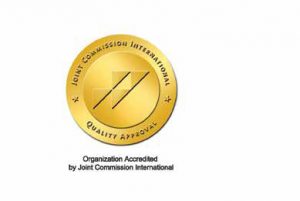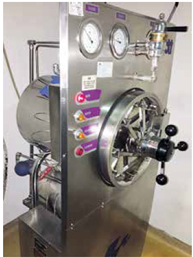 1. Update on Standard Steam sterilization
1. Update on Standard Steam sterilization
The Joint Commission International (JCI) is considered one of the most reputed bodies among health care accreditation organizations. India has many hospitals accredited by JCI and these include four ophthalmology centres too.
In the routine surveys conducted by JCI, it has been noted that there are one or more lapses in infection control practices most of which centre around reprocessing of equipment. While JCI continues to ensure more stringent controls, ASCRS and AAO representatives highlighted the need for evaluating ophthalmologypractices a little differently from other surgical practices. This is in light of differences in instrumentation size and degree of contamination of ophthalmic equipment as compared to a general surgical or orthopedic equipment. While general surgical instruments which are exposed to large amount of blood and body fluids, ophthalmic equipment is generally exposed to aqueous or vitreous humor. Also the cleaning practices of more robust instruments may not apply to the delicate and more lumen based instruments of eye surgery. Finally, even a small residue of a sterilizing agent on an ophthalmic instrument can cause havoc such as toxic anterior segment syndrome, such residues may cause no effect at all in larger cavities such as the thorax or abdomen.
Keeping in view these aspects, JCI issued a clarification on steam sterilization (which is most commonly used for ophthalmic instruments). The commission mentioned that for cleaning/decontamination, all visible soil must be removed before sterilization as steam cannot penetrate soil and those who clean instruments must be careful to follow manufacturers’ instructions. Sterilization itself can take place with steam, although other methods are acceptable too. It is important to ensure that steam sterilization of all types meets the parameters (time, temperature, and pressure) specified by both the manufacturer of the sterilizer, the maker of any wrapping or packaging, and the manufacturer of the surgical instrument. It mentions the need to avoid the term “Flash sterilization”, as it does not have a standard connotation globally and may not always follow established standards.
Those who sterilize instruments must be careful that the instrument is not recontaminated. “Instruments subject to steam sterilization using methods other than full cycle sterilization may be transported in ‘flash pans’ or other devices specifically designed for the prevention of contamination during and after the steam process,” according to The Joint Commission clarification. JCI now pays more attention to the entire infection control process rather than the act of steam sterilization alone and are able to document lapses when organizations take shortcuts in the correct method. Transport of instruments from one location to another is also carefully monitored and particularly thin the operating theater.
Taking on from these discussions, certain health care accrediting organizations have allowed subspecialty societies to form guidelines and protocols for infection control and instrument sterilization. In India, too we have seen AIOS members as part of NABH committees to develop specific guidelines which cater to ophthalmology setups. The ASCRS also developed ophthalmology-specific instrument handling guidelines in 2007 to focus on avoiding the spread of TASS. These guidelines were published in the Journal of Cataract & Refractive Surgery.
We recommend that each ophthalmologist should review their instrument cleaning and sterilization protocols and try to comply with infection control practices even if not accredited. This will play as a safeguard against surgical site
infections and the more dreaded clutter infections.
2. Update on Instrument Reprocessing – Immediate Use Steam Sterilization (IUSS)
Immediate-Use Steam Sterilization (IUSS), formerly termed “flash” sterilization, is described as the shortest possible time from the item being removed from the sterilizer to the aseptic transfer onto the sterile field. The items have to used immediately and cannot be stored. This form of sterilization has been frowned upon by many due frequent inadherence with processes. Currently JCI has updated guidelines with regard to this and now ststes that it may be used ins special circumstances provided that the manufacturer and equipment guideline with this regard are followed. It may be used: when a specific instrument is needed for an emergency procedure or when a non replaceable instrument has been contaminated and needs to be replaced to the sterile field immediately or when an item has dropped on the floor and is needed to continue a surgical procedure. It should not be used as a matter of convenience.
 JCI also mentions the case where a specialist ophthalmologist visits another practitioner for surgery and carries a tray with him to autoclave before the surgery. They point out that in cases of such ‘loaner’ tray, sufficient time has to be provided to the operating theater or CSSD staff to follow full protocol and ensure proper sterilization. They advise organizations to develop policies, procedures, staff orientation and competencies based on evidence-based guidelines for such reprocessing. During surveys, all places where IUSS is being practiced in an organization are always closely monitored.
JCI also mentions the case where a specialist ophthalmologist visits another practitioner for surgery and carries a tray with him to autoclave before the surgery. They point out that in cases of such ‘loaner’ tray, sufficient time has to be provided to the operating theater or CSSD staff to follow full protocol and ensure proper sterilization. They advise organizations to develop policies, procedures, staff orientation and competencies based on evidence-based guidelines for such reprocessing. During surveys, all places where IUSS is being practiced in an organization are always closely monitored.
NABH: New Guidelines
NABH has been working with various members of the ophthalmology specialty and have published special standards for Eye Care Organisation (ECO) in September 2016. These standards, tailored to stand-alone ophthalmology setups, provide framework for quality assurance and quality improvement with focus on patient safety and quality of care. The standards call for continuous monitoring of sentinel events and comprehensive corrective action plans leading to building of quality culture at all levels and across all the functions. There are 10 chapters in the standard which reflect two major aspects of healthcare delivery i.e. patient centered functions (chapter 1-5) and healthcare organisation centered functions (chapter 6-10). Chapter 5 focusses on infection control.